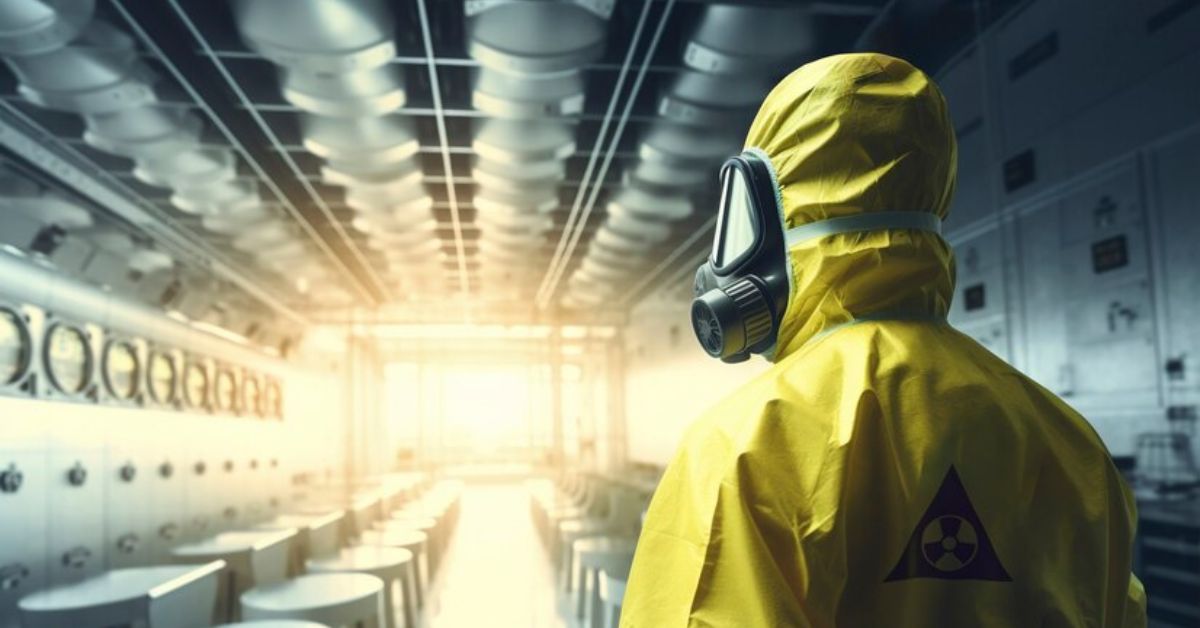Topic
Biohazard Cleanup: Ensuring Safety and Compliance

Biohazard cleanup is a critical process that involves the removal and decontamination of hazardous materials to ensure safety and compliance with health regulations. Biohazard situations can arise from various incidents, including crime scenes, accidents, chemical spills, and infectious disease outbreaks. Proper handling and disposal of biohazardous materials are essential to protect human health and the environment. This comprehensive guide provides an overview of biohazard cleanup, types of biohazard situations, health and safety protocols, and the importance of professional cleanup services.
In the event of an unforeseen biohazard incident, having access to a reliable and prompt service is essential. A 24/7 Emergency Restoration St. George team ensures that all biohazard situations are addressed swiftly, providing peace of mind and comprehensive cleanup services around the clock.
Types of Biohazard Situations
Biohazardous materials can pose significant risks if not handled correctly. Various situations can create biohazard conditions, requiring specialized cleanup procedures. Here are some common types of biohazard scenarios:
1. Crime Scenes and Trauma
Crime scenes and trauma incidents, such as homicides, suicides, and accidents, often involve blood, bodily fluids, and other biological materials. These materials can carry pathogens that pose health risks to anyone who comes into contact with them.
2. Hoarding Situations
Hoarding can create environments filled with hazardous materials, including mold, bacteria, and decaying organic matter. The accumulation of items and waste can lead to infestations of rodents and insects, further complicating the cleanup process.
3. Chemical Spills
Chemical spills, whether industrial or residential, can involve hazardous substances that are toxic, corrosive, or flammable. Proper containment and neutralization are necessary to prevent environmental contamination and health risks.
4. Infectious Disease Outbreaks
Outbreaks of infectious diseases, such as COVID-19, Ebola, and hepatitis, require thorough decontamination to prevent the spread of pathogens. Cleanup involves disinfecting surfaces, equipment, and air systems to eliminate the risk of transmission.
5. Sewage Backups
Sewage backups can introduce harmful bacteria, viruses, and parasites into the environment. These pathogens can cause severe illnesses if not properly managed and cleaned up.
6. Animal Infestations
Animal infestations, including rodents, birds, and insects, can create biohazard conditions through droppings, urine, and carcasses. These materials can carry diseases and pose health risks to humans.
Health and Safety Protocols
Biohazard cleanup requires strict adherence to health and safety protocols to protect workers and the public. The following steps outline the essential protocols involved in biohazard cleanup:
Personal Protective Equipment (PPE)
Workers must wear appropriate PPE to protect themselves from exposure to hazardous materials. PPE typically includes:
- Gloves: To prevent direct contact with biohazardous materials.
- Masks and Respirators: To protect against inhalation of harmful particles and pathogens.
- Goggles and Face Shields: To protect the eyes and face from splashes and airborne contaminants.
- Protective Suits: To prevent contamination of clothing and skin.
Containment and Isolation
The affected area must be contained and isolated to prevent the spread of biohazardous materials. This involves:
- Setting Up Barriers: Using plastic sheeting and other materials to create physical barriers.
- Establishing Negative Pressure: Using air filtration systems to maintain negative pressure and prevent contaminants from escaping the containment area.
- Controlling Access: Limiting access to authorized personnel only.
Safe Handling and Disposal
Proper handling and disposal of biohazardous materials are crucial for safety and compliance. This includes:
- Collecting and Containing: Using appropriate containers and bags for collecting and containing biohazardous materials.
- Labeling: Clearly labeling containers with biohazard symbols and relevant information.
- Transporting: Following regulations for transporting biohazardous waste to disposal facilities.
- Disposing: Using licensed disposal facilities for the safe destruction of biohazardous materials.
Decontamination and Disinfection
Decontamination and disinfection are essential to eliminate pathogens and ensure a safe environment. This involves:
- Cleaning: Removing visible debris and organic matter from surfaces.
- Disinfecting: Using EPA-approved disinfectants to kill pathogens on surfaces.
- Testing: Conducting tests to verify the effectiveness of the decontamination process.
Training and Certification
Biohazard cleanup workers must undergo specialized training and certification to handle hazardous materials safely. Training covers:
- Hazard Recognition: Identifying different types of biohazardous materials and their risks.
- Safe Practices: Learning safe handling, containment, and disposal procedures.
- Emergency Response: Preparing for potential emergencies and knowing how to respond effectively.
Importance of Professional Cleanup Services
Engaging professional biohazard cleanup services is crucial for ensuring thorough and compliant remediation. Here are some reasons why professional services are essential:
Expertise and Experience
Professional cleanup companies have the expertise and experience to handle a wide range of biohazard situations. They understand the risks involved and know how to manage them effectively, ensuring that the cleanup process is conducted safely and efficiently.
Specialized Equipment
Biohazard cleanup requires specialized equipment and tools that professionals are equipped with. This includes air filtration systems, containment barriers, and EPA-approved disinfectants. Using the right equipment ensures that the cleanup is thorough and compliant with regulations.
Compliance with Regulations
Biohazard cleanup is subject to strict regulations and guidelines set by organizations such as OSHA, EPA, and CDC. Professional cleanup services are well-versed in these regulations and ensure that all procedures comply with legal requirements, protecting you from potential liabilities.
Health and Safety
Professional cleanup services prioritize health and safety, implementing rigorous protocols to protect workers and the public. They use appropriate PPE, follow containment procedures, and ensure proper decontamination to eliminate health risks.
Peace of Mind
Hiring professionals for biohazard cleanup provides peace of mind, knowing that the situation is being handled by experts. It allows you to focus on other important matters while ensuring that the cleanup is completed safely and thoroughly.
Steps Involved in Biohazard Cleanup
Biohazard cleanup is a multi-step process that involves assessment, containment, removal, decontamination, and restoration. Here is an overview of the typical steps involved:
1. Initial Assessment
The first step is to conduct a thorough assessment of the biohazard situation. Professionals will evaluate the extent of contamination, identify the type of biohazardous materials, and develop a cleanup plan. This assessment helps determine the necessary resources, equipment, and safety measures required.
2. Containment and Isolation
To prevent the spread of contaminants, the affected area is contained and isolated. This involves setting up physical barriers, establishing negative pressure, and controlling access to the area. Containment ensures that biohazardous materials are confined to a specific area, reducing the risk of exposure.
3. Removal of Biohazardous Materials
Biohazardous materials are safely removed from the affected area. This includes collecting and containing blood, bodily fluids, chemicals, and other hazardous substances. Proper handling and disposal procedures are followed to ensure compliance with regulations and prevent environmental contamination.
4. Decontamination and Disinfection
The affected area is thoroughly cleaned and disinfected to eliminate pathogens and contaminants. Specialized cleaning agents and techniques are used to ensure that all surfaces, equipment, and air systems are decontaminated. This step is crucial for restoring a safe and healthy environment.
5. Final Inspection and Testing
After decontamination, a final inspection and testing are conducted to verify the effectiveness of the cleanup process. Professionals use testing methods to ensure that all biohazardous materials have been removed and that the area is free from contaminants.
6. Restoration
The final step involves restoring the affected area to its pre-contamination condition. This may include repairing or replacing damaged structures, repainting, and reinstalling fixtures. The goal is to return the property to a safe and habitable state.
Legal and Regulatory Considerations
Biohazard cleanup is subject to various legal and regulatory considerations to ensure safety and compliance. Here are some key regulations and guidelines:
Occupational Safety and Health Administration (OSHA)
OSHA sets standards for worker safety in biohazard cleanup situations. This includes guidelines for PPE, training, and safe handling procedures. Employers must comply with OSHA regulations to protect workers from exposure to hazardous materials.
Environmental Protection Agency (EPA)
The EPA regulates the disposal of biohazardous waste to prevent environmental contamination. This includes guidelines for the collection, transportation, and disposal of hazardous materials. Compliance with EPA regulations ensures that biohazardous waste is managed safely and responsibly.
Centers for Disease Control and Prevention (CDC)
The CDC provides guidelines for the prevention and control of infectious diseases. This includes recommendations for decontamination and disinfection procedures to eliminate pathogens. Following CDC guidelines helps prevent the spread of infectious diseases in biohazard cleanup situations.
Local and State Regulations
Local and state regulations may also apply to biohazard cleanup. These regulations can vary depending on the type of biohazard situation and the specific requirements of the jurisdiction. It’s important to be aware of and comply with all applicable local and state regulations.
Conclusion
Biohazard cleanup is a critical process that ensures the safety and health of individuals and the environment. Understanding the types of biohazard situations, health and safety protocols, and the importance of professional cleanup services is essential for effective remediation. By adhering to strict guidelines and engaging professional services, you can ensure thorough and compliant biohazard cleanup, protecting yourself, your property, and the public. Whether dealing with crime scenes, chemical spills, or infectious disease outbreaks, proper biohazard cleanup is vital for maintaining a safe and healthy environment.
Topic
Debt Consolidation with Zero Debt

Debt Consolidation: A Financial Strategy for a Stress-Free Future
Debt can often feel like a heavy burden, especially when juggling multiple payments, interest rates, and due dates. For many Latino families, finding a way to regain control over their financial future is essential.
Debt consolidation offers a practical strategy to manage and simplify your debts, paving the way to financial stability.
The Growing Debt Crisis
Debt can creep into your financial life in various ways—high-interest credit cards, medical bills, personal loans, and more. While these financial tools can help during emergencies or major life events, they often create stress when balances become difficult to manage.
For Latino families, balancing multiple financial responsibilities while managing cultural or familial obligations can be particularly challenging.
Beyond the financial strain, debt also impacts mental health, causing anxiety, stress, and even strained personal relationships. Recognizing the signs of financial overload early can help you regain control before it’s too late.
What Is Debt Consolidation?
At its core, debt consolidation combines multiple debts into one single payment—often with a lower interest rate.
This is typically done through a consolidation loan or program, which pays off your existing debts. Instead of managing numerous accounts and payments, you streamline your finances into one fixed monthly amount.
Debt consolidation won’t erase your debt, but it can make payments easier to manage and help you avoid missed deadlines or extra fees. For many in the Latino community, it’s a powerful step toward financial stability, lowering stress, and building a stronger future for your family.
Key Benefits of Debt Consolidation
Debt consolidation offers several advantages beyond simplifying your payment schedule. Here’s how it can positively impact your financial situation:
1. Lower Interest Rates
Consolidation loans usually offer much lower interest rates compared to credit cards or payday loans. This means you save money in the long run—money that could be used for your family or other important goals—and get out of debt faster.
2. One Monthly Payment
Keeping track of multiple bills is stressful. With debt consolidation, you’ll have just one easy monthly payment, helping you stay organized and avoid missing deadlines. Managing your finances becomes simpler and more manageable.
3. More Room in Your Budget
Lower interest rates or longer repayment terms can reduce your monthly payments, freeing up extra cash for essentials like groceries, emergencies, or even sending money to family back home.
4. Build a Stronger Credit Profile
By paying off high-interest debts and staying consistent with your consolidated loan, you can boost your credit score over time. This opens doors to better financial opportunities, like buying a home or starting a business.
5. Less Stress, More Focus
Debt isn’t just financial—it impacts your peace of mind. Consolidating your debt can help relieve that emotional burden, giving you and your family the chance to focus on brighter priorities, like building a better future.
Who Should Consider Debt Consolidation?
Debt consolidation isn’t a one-size-fits-all solution, but it’s especially beneficial if you find yourself in any of these situations:
- Struggling to keep track of multiple debt payments.
- Paying high interest rates that are keeping you from reducing the principal balance of your debt.
- Feeling overwhelmed or anxious about the amount of debt you owe.
- Experiencing financial difficulty but still maintaining a steady income.
If your financial obligations align with any of these scenarios, it may be time to explore debt consolidation as a solution to your challenges.
How Zero Debt Can Help
For Spanish-speaking individuals and Latino families across the U.S., companies like Cero Deuda specialize in providing debt relief services tailored to your needs.
Why Choose Zero Debt?
Cero Deuda is trusted by Hispanic families to help achieve financial freedom while maintaining a culturally empathetic approach. Their personalized service makes the process more accessible and less intimidating for Spanish-speaking clients.
Here’s how their programs work:
- Free Financial Consultation – Cero Deuda’s Spanish-speaking debt specialists assess your financial situation and identify potential savings with zero obligation, making it easy for Latino communities to get started. This Hispanic debt relief service is designed to provide personalized assistance and ensure that you fully understand your options before making any decisions.
- Personalized Debt Resolution Plan – After your consultation, Cero Deuda crafts a customized plan tailored to your lifestyle and budget, all in Spanish to ensure clear and effective communication.
- Creditor Negotiation – Their experts negotiate directly with your creditors, often in as little as 12-48 months, working to reduce your debt while keeping the needs of the Latino community in mind.
- Guidance and Support – Cero Deuda provides ongoing support in Spanish, empowering you with financial tips and resources on your journey to becoming debt-free.
Cero Deuda focuses on unsecured debt like credit cards and loans, and they’re committed to providing culturally respectful, professional services in Spanish. Many satisfied clients share positive Cero Deuda reviews, highlighting their dedication to helping the Hispanic community achieve financial freedom with tailored solutions and a personal touch.
Success Story
“After struggling for years to rebuild our finances post-pandemic, we discovered Cero Deuda. Thanks to their support, we’ve reduced our monthly payments and, for the first time in years, feel hopeful about our future!” – Carmen R.
Is Debt Consolidation Right for You?
If you’re unsure whether debt consolidation is your best option, here are a few questions to ask yourself:
- Do you owe more than $7,500 in unsecured debt?
- Are you struggling to afford the minimum payments on your credit cards or other loans?
- Do you have a steady income but still feel buried under financial obligations?
If you answered “yes” to any of these questions, debt consolidation might be the right step toward financial freedom.
Take the First Step Toward a Stress-Free Future
Managing debt doesn’t have to be a solitary or overwhelming process. With support from experts like Cero Deuda, you can simplify your finances, reduce your stress, and regain control of your financial future.
Are you ready to take the first step? Learn more about their debt consolidation solutions and book a free consultation today.
Remember, every step toward financial freedom—no matter how small—is a significant step toward a brighter, stress-free future.
Topic
Harnessing the Power of Laravel Pipelines

Laravel provides an elegant way to manage complex workflows and processes in an application. Through its built-in features, developers can streamline tasks, making code more maintainable and efficient. One of the most powerful tools in this ecosystem is the Laravel pipeline, a flexible method to manage operations sequentially. Below, we will explore how Laravel pipelines can simplify complex tasks and improve the structure of your code.
Streamlining Application Logic with Laravel Pipelines
Laravel pipelines offer a straightforward approach to handling a series of tasks. Instead of relying on complex conditional statements, the pipeline allows you to chain operations, each performing a discrete action. This improves the readability and maintainability of your codebase, making it easier for developers to debug or modify workflows.
Chaining operations isolates specific parts of your logic, enabling a modular design. With each task encapsulated within its pipeline step, you ensure that future changes to any part of the process don’t require extensive rewrites. This reduces technical debt, allowing developers to focus on other application areas without worrying about breaking existing functionality.
The flexibility of Laravel pipelines also makes them ideal for managing dependencies between tasks. Each step can conditionally pass data along, allowing the next operation to use previously generated information. This seamless flow between tasks ensures a smooth transition from one operation to the next, eliminating unnecessary complexity.
Finally, Laravel pipelines support multiple configurations, making them adaptable to various business logic requirements. Whether you’re building a customer service tool or an e-commerce platform, Laravel pipelines help you stay organized and reduce the likelihood of errors. This approach results in faster development cycles and more reliable software.
Simplifying Complex Processes Using Laravel Pipelines
When handling complex processes, breaking them down into manageable steps is crucial. Laravel pipelines allow you to do this effortlessly by structuring operations in a clear sequence. This decomposition ensures that each individual process focuses on one aspect of the overall workflow, making it easier to troubleshoot and refine as needed.
In scenarios where tasks are interdependent, pipelines provide a natural data flow. By sending the output of one operation directly to the next, you ensure that each step gets the necessary information to continue. This eliminates the need for manual data handling and reduces the potential for errors when passing variables between functions.
Moreover, Laravel pipelines work well for handling actions that require multiple conditions. You can chain operations and let each one decide whether to continue, apply specific logic, or skip over certain steps. This adaptive capability simplifies managing workflows where conditions vary based on external inputs or configuration settings.
Pipelines are also useful in scenarios that require repeated task execution, such as processing large datasets or filtering items. Structuring each action as part of a pipeline allows you to reuse code without repeating the same logic. This approach ensures consistency and optimizes performance by reducing the overhead of redundant operations.
Best Practices for Implementing Laravel Pipelines in Your Project
The key to successfully implementing Laravel pipelines is ensuring that each step is focused and concise. Avoid bundling multiple tasks into a single step, as this can reduce clarity and hinder maintainability. By adhering to the principle of single responsibility, each operation in the pipeline becomes more predictable and easier to test.
One best practice is to keep the pipeline flexible enough to adapt to changes. Design your pipelines to be extensible, allowing additional tasks to be easily added or removed. This flexibility ensures you can scale the pipeline without disrupting its flow or introducing bugs into existing functionality as your application evolves.
It’s important to optimize your pipeline’s performance. While Laravel pipelines are generally efficient, complex or unnecessary steps can introduce performance bottlenecks. Always consider the cost of each operation and focus on minimizing redundant tasks, especially when dealing with large volumes of data or intricate workflows.
Lastly, ensure thorough testing of each pipeline step to guarantee that the overall process functions as intended. Laravel provides excellent testing tools, which you can leverage to validate each operation in isolation. This approach helps detect errors early in development and ensures the pipeline operates smoothly across various scenarios.
Altogether, Laravel pipelines offer a powerful solution for managing complex workflows with simplicity and flexibility, enabling developers to build more efficient and maintainable applications. By implementing best practices, optimizing performance, and ensuring thorough testing, developers can significantly enhance the scalability and reliability of their projects over time.
CLICK HERE FOR MORE BLOG POSTS
Topic
The Top Power Tools Every DIY Enthusiast Should Own

For DIY enthusiasts, having the right tools can transform a hobby into a passion, enabling precise work and professional-quality results on home projects. Among the essentials for any DIY toolkit are power tools, particularly those offered by Powerhousexpress in Pakistan.
In this article, we focus on the indispensable corded power tools that every DIYer should own to tackle a wide range of tasks efficiently and safely.
Essential Corded Power Tools for DIY Projects
- Corded Drill: The cornerstone of any power tool collection, a corded drills offers unmatched reliability and power for drilling through various materials, including wood, metal, and masonry. Powerhousexpress models are known for their durability and robust performance, ensuring that even the toughest drilling jobs are completed with ease.
- Circular Saw: For cutting through wood or other materials with precision and speed, a circular saw is indispensable. It’s ideal for making straight cuts and is a must-have for tasks like trimming doors, cutting shelving, or even tackling larger projects like building a deck.
- Jigsaw: When it comes to making intricate cuts in wood or metal, a jigsaw is your go-to tool. Perfect for cutting curves and complex shapes, it’s essential for tasks such as cutting out sink holes in countertops or crafting custom pieces of furniture.
- Orbital Sander: Achieving a smooth finish on wood projects is effortless with an orbital sander. It’s much faster and more effective than sanding by hand, and it’s ideal for preparing surfaces for painting or staining.
- Reciprocating Saw: Known for its versatility, a reciprocating saw is crucial for demolition projects or for cutting through tough materials like piping, fiberglass, and even tile. Its push-and-pull motion allows for aggressive cutting actions that other saws cannot achieve.
- Bench Grinder: For sharpening tools, grinding down metal parts, or even smoothing rough edges, a bench grinder is a valuable addition to your workshop. It’s also useful for shaping metal and cleaning objects before welding or fitting.
The Advantages of Corded Tools
While cordless tools offer convenience and portability, corded tools win in terms of uninterrupted power and performance. They are generally more powerful and do not require batteries, making them ideal for prolonged use on larger projects where stopping to recharge can disrupt workflow. Additionally, corded tools tend to be more cost-effective over the long term, as they do not require battery replacements.
Powerhousexpress Commitment to Quality
Powerhousexpress in Pakistan ensures that DIY enthusiasts have access to high-quality, reliable corded power tools that can handle a variety of tasks. Their products are engineered to meet the needs of both novice and experienced DIYers, providing performance, safety, and durability.
Tips for Choosing and Using Corded Power Tools
When selecting power tools, consider the specific needs of your projects, the tool’s power requirements, and its ergonomic design to ensure comfortable and safe usage. Always follow the manufacturer’s guidelines for use and safety, and wear appropriate protective gear, such as safety goggles and gloves.
Conclusion
Equipping yourself with the right corded power tools can make a significant difference in the quality and enjoyment of your DIY projects. With tools from Powerhousexpress, DIY enthusiasts in Pakistan can trust that they are using some of the best equipment on the market. Whether you’re a beginner or a seasoned pro, these tools will help you achieve your creative visions with precision and efficiency, making every project a success.

 Cartoon1 year ago
Cartoon1 year agoUnlocking the Potential of Nekopoi.care: A Comprehensive Guide

 Game1 year ago
Game1 year agoExploring Aopickleballthietke.com: Your Ultimate Pickleball Destination

 BUSINESS1 year ago
BUSINESS1 year agoWhat Companies Are In The Consumer Services Field

 BUSINESS11 months ago
BUSINESS11 months agoUnraveling the Mystery of 405 Howard Street San Francisco charge on Credit Card

 HOME IMPROVEMENT1 year ago
HOME IMPROVEMENT1 year agoVtrahe vs. Other Platforms: Which One Reigns Supreme?

 TECHNOLOGY11 months ago
TECHNOLOGY11 months agoThe Guide to Using Anon Vault for Secure Data Storage

 ENTERTAINMENT8 months ago
ENTERTAINMENT8 months agoUnderstanding Bunkr Album: A Comprehensive Guide

 ENTERTAINMENT1 year ago
ENTERTAINMENT1 year agoThe Epic Return: Revenge of the Iron-Blooded Sword Hound
















